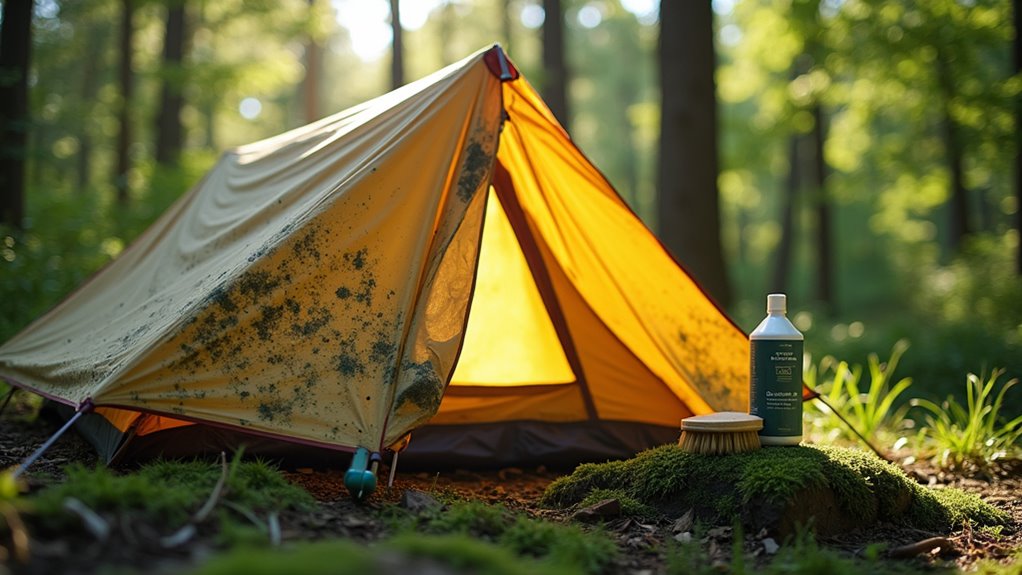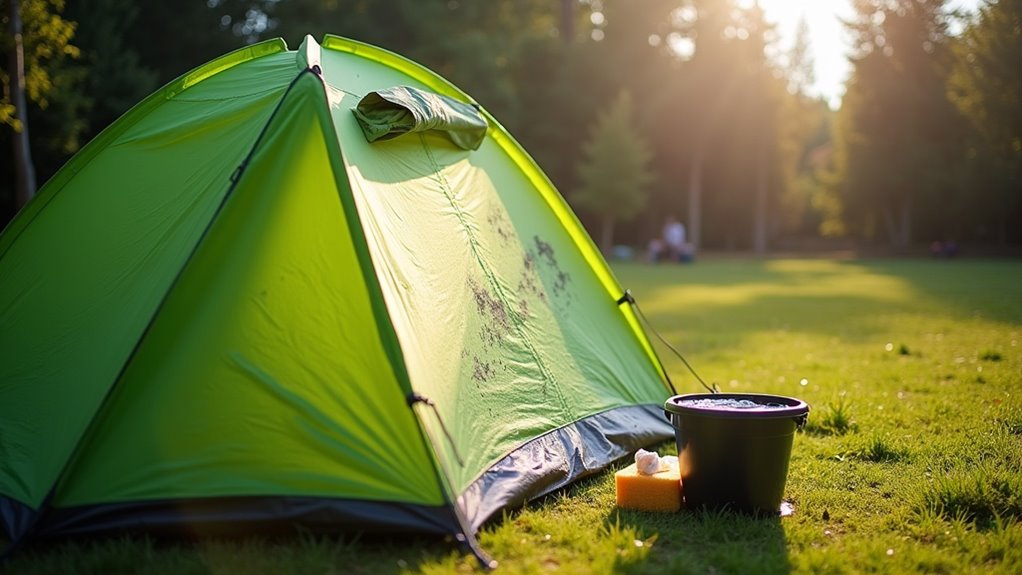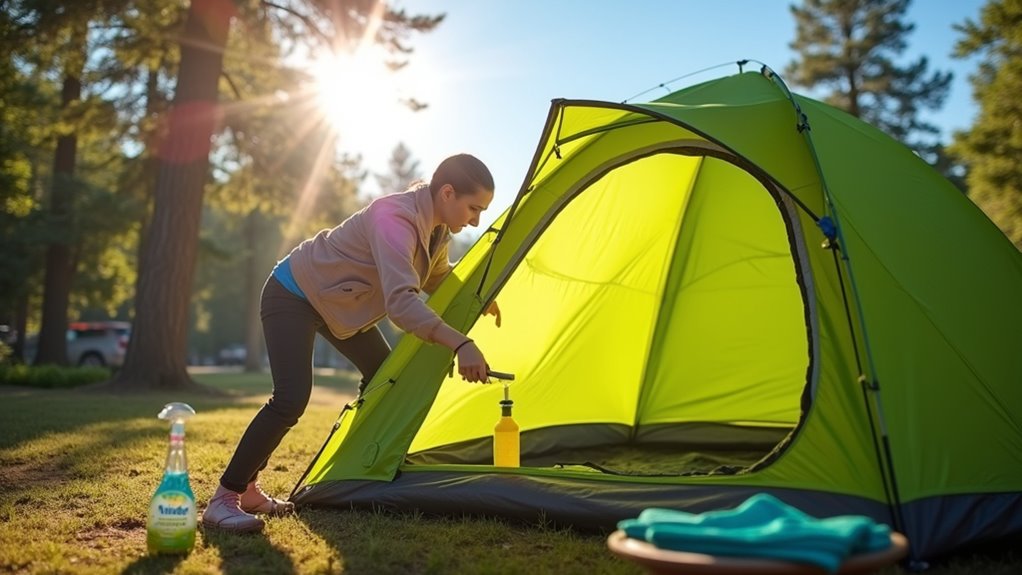How To Clean Mold Off Of A Tent
This post contains affiliate links. As an Amazon Associate, we earn from qualifying purchases.
To clean mold off your tent, identify the mold spots and treat them with mild solutions like vinegar or warm soapy water for light cases, or use a specialized cleaner like Break the Mold for tougher mold. Always test any cleaner on a small area first, scrub gently, rinse thoroughly to remove residue, and fully dry the tent before storage. Below, you’ll find more detailed steps and additional tips to help you effectively remove mold and prevent it in the future.
Essential Facts in 30 Seconds
- Inspect tents for mold at seams, stitching, and areas with a musty odor.
- Use warm water and mild soap or distilled white vinegar for light mold cleaning.
- Apply strong cleaners like Break the Mold for stubborn mold, following safety guidelines.
- Rinse tents thoroughly after cleaning to remove all chemical residues.
- Store tents fully dry in cool, dry places to prevent mold growth.
Identifying Mold on Your Tent

Before your camping trip, check the tent carefully for mold. Mold shows as spots in colors like black, green, brown, or blue. These colors mean different types of mold. Focus on seams, stitching, and zippers. Mold hides well in these places.
Smell the tent fabric. A strong musty smell means mold might be growing. Touch the fabric. Damp or sticky cloth can help mold grow. Regular checks can also help you catch mold growth early.
Use mold test strips or special liquids to find hidden mold. Camping in wet, humid places raises the chance of mold.
Mold can damage your tent and affect your health. Cleaning tent mold early to avoid problems is crucial.
Choosing the Right Cleaning Solutions
Mold on your tent needs the right cleaner. Light mold cleans well with warm water and mild soap. This method keeps the fabric safe. Regularly checking for mildew spots can help identify areas that need attention.
Stubborn mold demands stronger cleaners. Products like Break the Mold work well here. They remove tough mold without hurting your tent. Always follow the cleaner’s instructions for best results. Clean tent fabric lasts longer and stays safe to use. Regular maintenance can help prevent future mildew growth and ensure your tent remains in top condition.
Mild Solutions for Light Mold
Light mold on a tent needs a gentle touch. Distilled white vinegar kills mold spores well. Spray it on mold spots and wait for it to work. To prevent mold from returning, ensure the tent is completely dry before storage.
Lemon juice mixed with salt also cleans and scrubs softly. Mix lemon juice, salt, and warm water, then scrub gently. Mild dish soap with warm water helps, but don’t scrub hard. Test any cleaner on a small tent area first. This stops damage and keeps your tent safe. Proper maintenance techniques can further enhance the longevity of your camping gear.
Use these simple steps for fresh, clean fabric.
Strong Cleaners for Stubborn Mold
Strong cleaners work best on stubborn mold in tents. Break the Mold contains 5% calcium hypochlorite. It kills mold, mildew, and algae fast.
Use gloves and open windows for safety. Iosso Canvas Tent Cleaner is a good biodegradable choice. It cleans tough stains without harming fabric.
Always dilute granular cleaners as the label says. Test a small spot first to check for color loss. Rinse the tent well to remove any chemical leftover. This stops damage and keeps your tent safe.
Step-by-Step Cleaning Process

Gather your supplies before cleaning your tent. This makes mold removal easier and faster.
Wear rubber gloves and a mask. These protect you from mold spores.
Mix warm water with a mild detergent. This solution cleans mold gently.
Use a soft brush or sponge. These tools prevent fabric damage.
Keep white vinegar or enzyme cleaners like MiraZyme™ handy. They remove tough stains.
Spread your tent in a fresh, open space. Brush off dirt and mold carefully.
Apply the soapy solution to stained areas. Rinse well with clean water afterward.
This routine cleans your tent deeply and stops mold from coming back. Make sure to verify the tent is completely dry before storage to prevent mold.
Clean often to keep your tent fresh and safe.
Tackling Stubborn and Black Mold
Tackling stubborn and black mold is possible with the right tools and steps. Use a stiff brush or vacuum to clear loose mold first.
Clean the area with vinegar or tea tree oil mixed with water. These natural cleaners kill many types of mold. Special cleaners like Concrobium and MiraZyme™ also work well. They break down tough mold spores.
Spray the cleaner and scrub gently with a sponge. Avoid scrubbing too hard on delicate spots, such as zippers. Don’t leave chemicals on fabric for more than an hour. This could harm your tent.
Rinse the tent well to remove all cleaner residue. Clean fabric lasts longer and stays stronger.
Patience helps you get better results. Using the right cleaning methods keeps your tent fresh and safe. Mold stains will fade, and your tent will last many camping trips.
Preventive Measures for Mold Prevention

Mold grows fast on wet tents. Control moisture and air flow to stop it. Follow these four steps:
- Store tents in cool, dry places. Moisture stays low there. Additionally, proper ground cover can help create a drier environment by preventing moisture from seeping into the tent.
- Use dehumidifiers or silica gel packs. They soak up extra dampness.
- Open vents, windows, or mesh panels. Air moves better, mold can’t grow.
- Dry tents fully in sunlight or fresh air. No wet spots left behind. Additionally, pitch the tent tightly to prevent water seepage, as this helps maintain a dry environment.
These simple steps keep your tent fresh and mold-free.
Additional Tips for Tent Maintenance
Regular tent care keeps it strong and ready for your next trip. Clean the fabric after each use using mild soap and warm water. A soft brush helps remove dirt and mold spores gently. Rinse well to stop soap from attracting more dirt.
Let the tent dry in sunlight and fresh air to stop mold from growing. Store your tent only when it’s fully dry. Keep it loose in a cool, dry spot. Use bags that breathe, so any small dampness can dry out.
Check the seams often for any damage. Seal them with the right sealer to keep water out. Apply waterproof treatments once a year to protect the fabric. This simple care can make your tent last many adventures. Additionally, regular maintenance enhances the tent’s lifespan by preventing mold growth and fabric damage.
Frequently Asked Questions
How Can I Tell if My Tent Is Still Safe to Use After Cleaning?
Check your tent carefully after cleaning. Look for mold signs like stains or bad smells. Feel the fabric for any weak spots or tears. Make sure all parts, like zippers and poles, work well. Test if the tent keeps water out by spraying it with water. Dry the tent fully in sunlight or a warm place. This stops mold from coming back. A clean, dry, and strong tent stays safe for your trips.
What Should I Do if Mold Returns After Cleaning?
Mold can come back even after cleaning. Clean the spots again carefully. Keep your tent dry and store it in a cool place. Air helps stop mold from growing. Use a mold-resistant spray for extra protection. Check your tent often to catch mold early. This stops big problems later. Stay safe and keep your gear clean.
Can I Use Commercial Bleach Products for Mold Removal?
Commercial bleach is not the best choice for mold removal. It can harm your tent fabric and may not kill all mold spores. Use bleach alternatives like vinegar or baking soda instead. These options clean mold safely and protect your tent. Keep your tent dry and well aired to stop mold from growing again. Good air flow and less moisture help prevent mold problems. Stay ahead by drying your tent after use and storing it in a dry place. This keeps mold away longer and keeps your tent strong.
Is It Safe to Use My Tent After Treating for Mold?
Using your tent after treating mold is safe. Clean the tent well. Wash all areas where mold grew. Dry the tent completely in the sun. Check for any mold spots left. Mold spores can cause health issues if not removed. Keep your tent dry to stop mold from coming back. Store it in a cool, dry place. Regularly inspect and clean your tent to stay safe. This care keeps your tent strong and healthy for your next trip.
How Often Should I Inspect My Tent for Mold?
Check your tent for mold at least once a year. Check more often during camping season. Mold grows fast in wet, warm places. Early checks stop mold from damaging your tent. Clean and dry your tent well after each trip. This keeps mold from growing. Small problems become big if you wait too long. Regular checks keep your tent safe and strong.
Conclusion
Keeping your tent free from mold helps it last longer and stay safe. Mold grows fast in damp, dark places. Clean your tent as soon as you see mold spots. Use simple cleaners like vinegar or special tent cleaning products. Scrub gently with a soft brush or cloth. Rinse well with water. Dry your tent completely before storing it to stop mold from coming back. Store your tent in a dry, cool place. Clean your tent regularly to keep it fresh. These steps help you enjoy camping without the worry of mold. Your tent stays strong, and your adventures stay fun.
